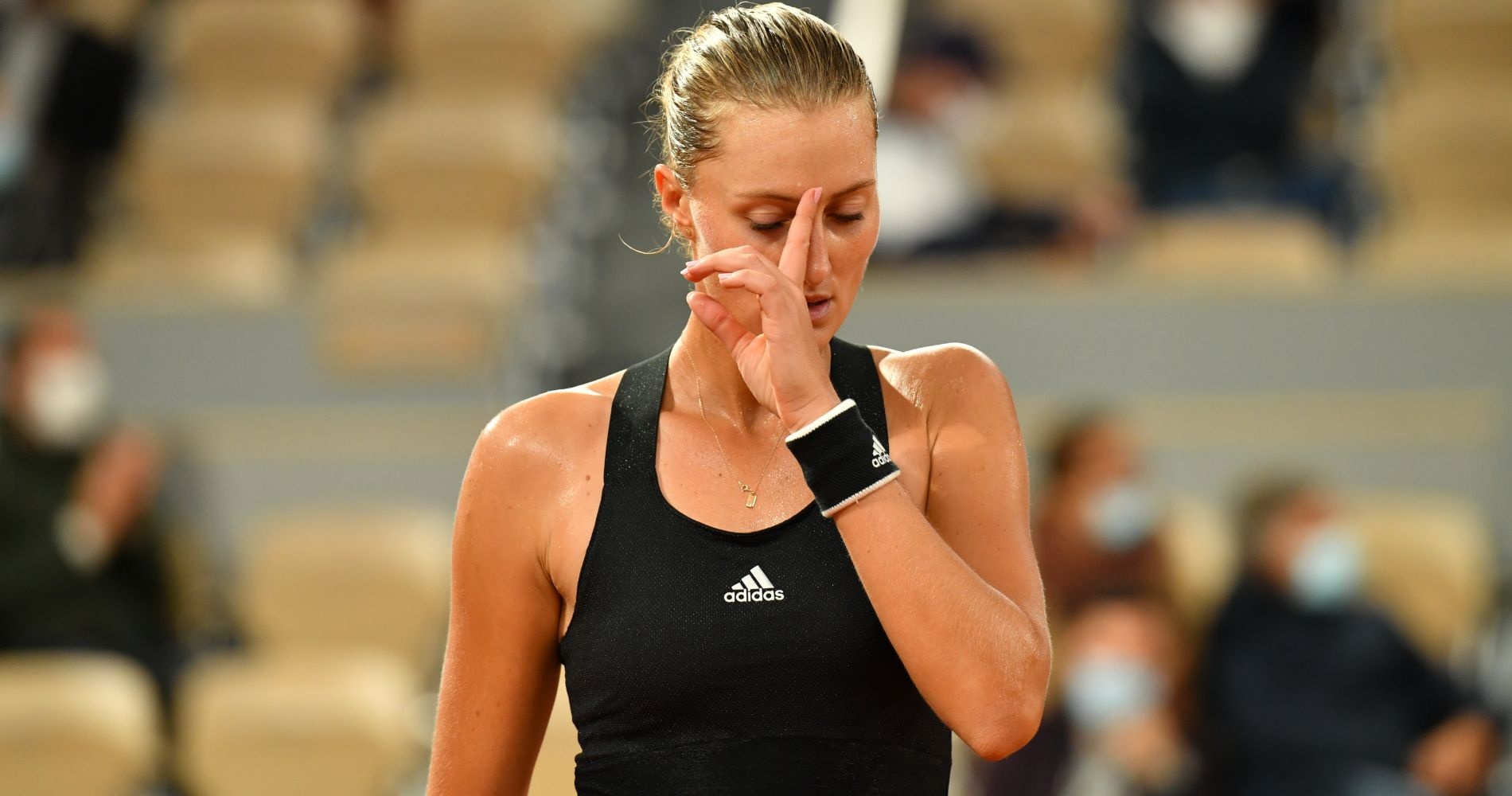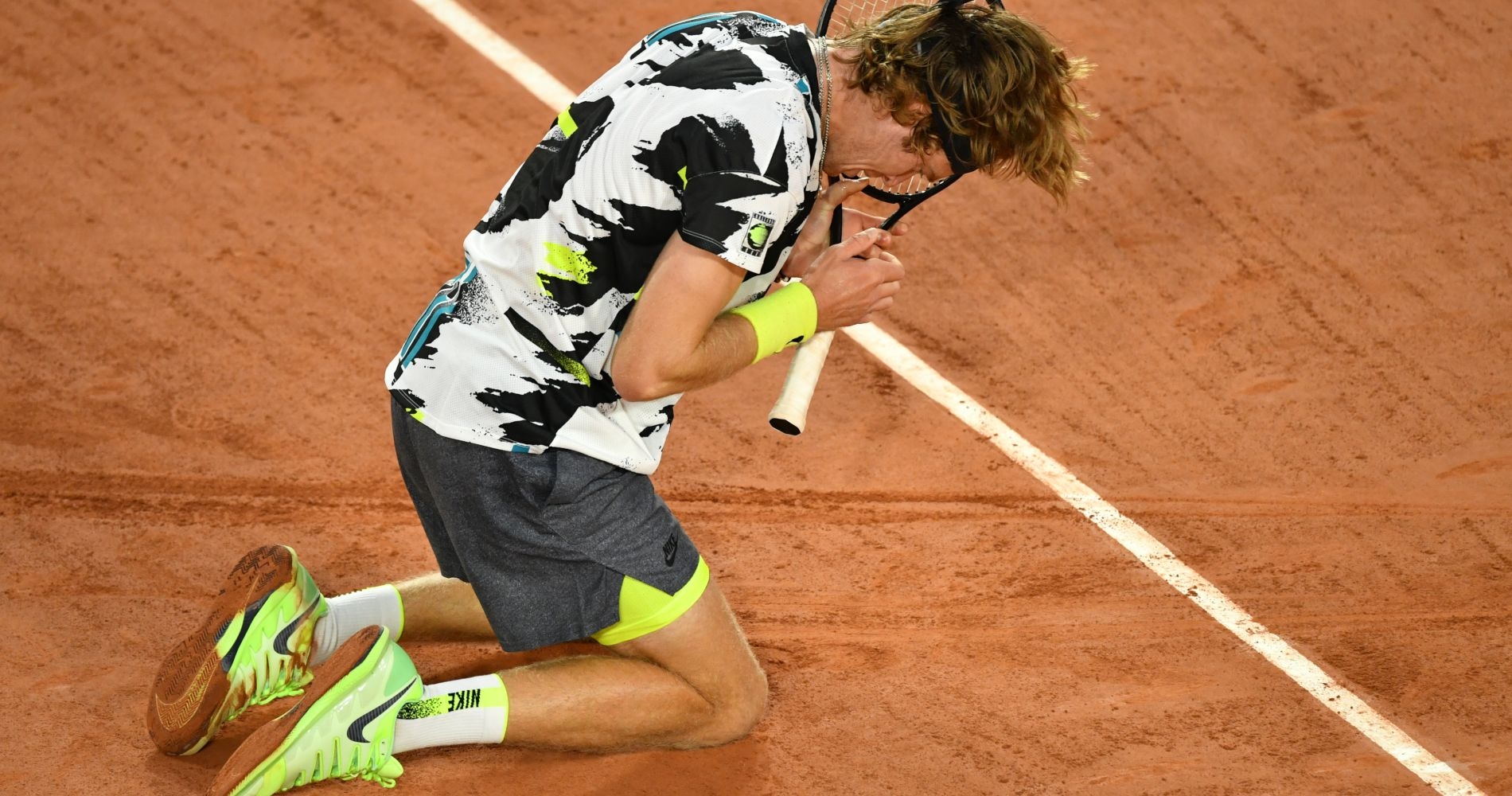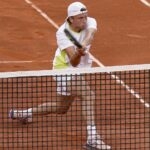Roland-Garros Day 3 recap: Crazy comebacks and another Kiki collapse
There were some more final-set thrillers on both the men’s and women’s sides at Roland-Garros on Tuesday. And there was controversy, too, as Kristina Mladenovic was undone by a terrible call in her match against Laura Siegemund.
 Kristina Mladenovic – Roland-Garros 2020
Kristina Mladenovic – Roland-Garros 2020
Day 3 at Roland-Garros had a little bit of everything — more rain, more cold, more controversy…. It also produced some amazing drama on the court: five-setters, three-setters, comebacks, collapses, and incredible shots.
When it was all said and done, the tournament had completed the first round. That is thanks to the new roof on Court Philippe-Chatrier, lights on the outer courts, and weather that was bad but could have been a lot worse.
The woman of the day: Tauson announces herself on tour
Clara Tauson, 17, did well just to qualify for the French Open main draw. Asking her to then beat US Open semi-finalist Jennifer Brady would probably be thought of as too tough a task. But it wasn’t so for the great Dane. Tauson battled to a 6-4, 3-6, 9-7 victory over the 21st-seeded American, advancing in improbable fashion after two hours and 45 minutes.
She was one of 16 players in both the women’s and men’s draws to earn their first-ever wins at a Grand Slam.
From 17 year old Clara Tauson to 32 year old Attila Balazs —players who scored their first ever Grand Slam wins at #RG20 pic.twitter.com/tFxSVYS6Xg
— Oleg S. (@AnnaK_4ever) September 29, 2020
The man of the day: Heroic comeback for Hamburg champion
On Sunday, Andrey Rublev beat Stefanos Tsitsipas in a three-set thriller for the Hamburg title. On Tuesday, Rublev was on Court Simmone-Mathieu at Roland-Garros going up against Sam Querrey in the first round of the year’s final Grand Slam.
It was quick turnaround for the Russian, so you could not blame him if he was finding things — everything, in fact — difficult on the court. Losing the first two sets to the unseeded American was bad, and it all went from bad to worse when Rublev trailed 5-2 in the first. Frustrated and fatigued, the Hamburg champion seemed to have one foot out of Paris.
That, however, is when he decided to fight back. Rublev started to sink his teeth into the match when Querrey failed to serve out the match at 5-3 in the third, and that proved to be the first and final turning point of the afternoon. With momentum finally in hand, Rublev went on to steal the third set and eventually completed his comeback for a 6-7(5), 6-7(4), 7-5, 6-4, 6-3 triumph.
Despite his epic comeback, Rublev was not entire pleased during his post-match press conference.
“My attitude was horrible,” the world No 13 admitted. “I was just so lucky. The attitude today was really horrible. If I want to improve and I want to compete on a good level, this is not acceptable. I need to change it.
“I was feeling completely tight. I choke (on) another level. Since the first point of the match till the last point of the match I was completely frozen. I couldn’t take one step; I could only hit. I was tight like I don’t know. Not many times I was tight like this.”
The match of the day: Hamburg runner-up accomplishes exact same feat
Just like the man who beat him in Hamburg, Tsitsipas also dug deep for five-set heroics. The world No 6 trailed Jaume Munar two sets to love only to storm back and win 4-6, 2-6, 6-1, 6-4, 6-4 after three hours and 12 minutes.
It was no fault of Tsitsipas’ that he trailed by two sets, nor was it any fault of Munar’s that he could not close out his upset bid. The underdog Spaniard played near-flawless tennis the entire way; the problem for him was simply that Tsitsipas raised his level when it mattered most. Munar finished with only 21 unforced errors while striking 38 winners — an incredible ratio, especially for someone who did not even win the match. Tsitsipas recorded 54 winners and 49 errors.
“I don’t think I’ve ever played a match like this before,” he said during his on-court interview. “The emotions were not there at the beginning. It wasn’t working out for me at all in the beginning; nothing was working. Everything was not responding. But I’m really proud of myself for the effort I put in and the amount of dedication.
“Playing a best-of-fiver can be very challenging. I’m very happy that I will walk away from Suzanne-Lenglen with a ‘W.'”
Sunday: Rublev & Tsitsipas play Hamburg final
Tuesday: Rublev & Tsitsipas both come back from 2 sets down to win in #RG20 R1
— Tennis TV (@TennisTV) September 29, 2020
The news of the day: Call controversy
Kristina Mladenovic, who blew a 6-1, 5-1 lead over Varvara Gracheva in the second round of the US Open, should have won the first set 6-1 against Laura Siegemund on Tuesday in Paris. Leading 5-1 with Siegemund serving down set point, Mladenovic appeared to clinch it with a successful drop-shot that double-bounced before being hit back over the net by the 32-year-old German. However, the chair umpire did not see the double-bounce and Siegemund ended up winning the point.
Laura Siegemund saved seven points to win the first set, 7-5, over Kiki Mladenovic, but did the German *truly* earn the comeback?
A missed call and lack of sportsmanship would suggest otherwise.
Passport to #RolandGarros // https://t.co/wJ0wjjpH1b pic.twitter.com/hKWdfZaz2W
— TENNIS (@Tennis) September 29, 2020
In fact, she won a lot more than just the point. The world No 66 proceeded to hold serve for 2-5 and went on to save six more set points — seven in total — before taking the set 7-5. Siegemund ended up winning the match in straight sets.
“It depends on the situation,” Siegemund said when asked if a player should make the call even if the umpire does not. “If it’s a close call and it’s a set point against you, I think it’s the umpire’s responsibility. If I’m coming running full speed, if in that call I say, ‘Oh, it was a double-bounce,’ and later I see on the video it was not, I would be angry at myself. So I think in that situation, that was a close call.”
“Obviously that double-bounce, it was set point, supposed to be 6-1, and I think the chair umpire was the only person not to have seen it on the center court,” Mladenovic commented. “So we can call that a turning point. I mean, (it) should have been 6-1. I don’t know about the outcome of the rest of the match after that, but, yeah, (it) was definitely a key point.”
The big surprise: Ugo goes home against lucky loser
Technically it was Tauson who pulled off the biggest surprise of the day, mainly because she is just 17 years old and Brady has been on fire this whole summer — highlighted by her semi-final appearance in New York City. In reality, however, Ugo Humbert losing to Marc Polmans was the the weirdest result. It won’t generate as many headlines as the Tauson-Brady outcome because Humbert isn’t a huge name in the sport; again, though, no one could have seen this coming.
After all, Polmans needed a lucky-loser spot just to get into the main draw. The 122nd Australian had lost to Liam Broady in qualifying, whereas Humbert was coming off a quarter-final performance in Hamburg that included an upset of Daniil Medvedev. The 38th-ranked Frenchman also advanced to the third round of the Rome Masters, beating Kevin Anderson and Fabio Fognini en route.
Somehow, though, Polmans produced a 6-2, 6-2, 3-6, 6-3 upset.
Polmans #RG20 (🎥@Eurosport_RU ) pic.twitter.com/9A7Wq1Ccuz
— doublefault28 (@doublefault28) September 29, 2020
The picture of the day: Different strokes for different folks
It is safe to say that Jelena Ostapenko was not employing the same tactics as Dominic Thiem — or Rafael Nadal, for that matter — during her first-round match against Madison Brengle. Whereas those two clay-court masters on the men’s side spend most of their time returning serve and playing points from many meters behind the baseline, Ostapenko utilised the Roger Federer-trademarked SABR tactic while facing Brengle. But there was nothing sneaky about it. The 2017 French Open champion did not even try to hide the fact that she was going to attack on a return with the American serving at 1-1 in the first set.
Tennis reporter Tumaini Caryol captured the difference between Ostapenko’s and Thiem’s return positions in this screenshot, which delighted Twitter users.
There are multiple ways to play this sport. pic.twitter.com/DklcrGYpG0
— Tumaini Carayol (@tumcarayol) September 29, 2020
The quote of the day: Pospisil complains
Vasek Pospisil got blown out by Matteo Berrettini and was not particularly happy about it — not about the loss, not about the balls, not about the tournament organization. Nothing.
“I mean, the balls are terrible,” he seethed. “These are balls that I would never practice with. But it is what it is.”
And he didn’t stop there. The Canadian was asked if he would leave Paris right away or stick around and talk about his involvement with the politics of the sport. Because he has reunited with Jack Sock for doubles in this tournament, Pospisil is obviously staying for as long as he is in that draw. But it’s safe to say that if he wasn’t playing doubles, he would have been on the next flight out of Paris.
“As soon as I’m done with doubles, I will leave the bubble because it’s not a very good bubble here they made for us. It’s not easy mentally to be in it. As soon as I have an opportunity to leave the bubble, I will. (It’s) much worse (than the US Open). At least for the players, the hotel we’re staying at…it’s tough. We don’t have anything. (At) the US Open there was a much bigger effort I felt from the organisation to make the time in the bubble a little bit more comfortable for the players. That’s for sure. I mean, I think almost every player I’ve spoken to was sharing the same opinion.
“It’s not easy to be stuck in the bubble. You don’t want to be on-site all day because it’s also a stressful environment. You have all the competitors around. You want to leave the site as soon as possible. The only place you can go is the hotel. Yeah, it’s not easy because you can’t even get fresh air. But that is what it is. Obviously, they didn’t know if the tournament was going to happen. I don’t know what the reason is, if they didn’t have very much time to try to make the conditions better for players, more comfortable. Obviously, some players are going to be here for two, three weeks, right, in the bubble.
“Yeah, I just thought the US Open was a lot better. They did a lot better job. There was a games room for the players. There was an outdoor area with a food truck, an area you could sit and lounge. Paris is a tough city because everything is closed, but it’s just a little bit more difficult mentally.”
The shot of the day: Ymer tweener
Not a whole lot went well in Mikael Ymer’s opening match on Tuesday afternoon. And nobody thought it would, as the 22-year-old Swede had to go up against none other than world No 1 Novak Djokovic. Predictably, Ymer suffered a lopsided 6-0, 6-2, 6-3 loss at the hands of the top-seeded Serb.
Nonetheless, there was one moment of magic for the world No 83. Already trailing by a set and a break, Ymer came up with a successful tweener passing shot that whizzed past his opponent for a winner, reducing Djokovic to impressed applause.
THIS tweener winner by Mikael Ymer 😍
(🎥 @rolandgarros) pic.twitter.com/ueWpKtpgGd
— We Are Tennis (@WeAreTennis) September 29, 2020
Day 4 matchups
The players plodded through three days of first-round action, some more successfully than others. Roland-Garros is the only remaining slam that extends the opening round over three days, but the fields have finally been sliced in half and we are ready for the second-round festivities to being on Wednesday.
Here are the updated men’s and women’s draws as action heads into round two. And here are some of the notable matchups on the upcoming schedule:
Men’s: (2) Rafael Nadal vs. Mackenzie McDonald
Men’s: (3) Dominic Thiem vs. Jack Sock
Men’s: (6) Alexander Zverev vs. Pierre-Hugues Herbert
Men’s: (16) Stan Wawrinka vs. Dominik Koepfer
Women’s: (3) Elina Svitolina vs. Renata Zarazua
Women’s: (6) Serena Williams vs. Svetana Pironkova
Women’s: (16) Elise Mertens vs. Kaia Kanepi
Women’s: Eugenie Bouchard vs. Daria Gavrilova







